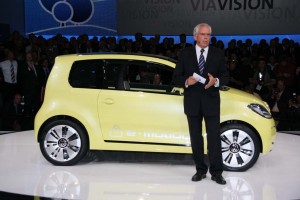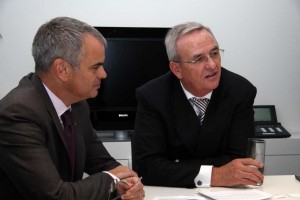
Governments may force the industry to build battery cars, like the 2013 Volkswagen e-Up, but governments will also need to subsidize their sale, says VW's global technology chief, Ulrich Hackenberg.
“If you build it, they will come,” goes the oft-quoted line from the film, “Field of Dreams.” That’s the guiding principle of the auto industry, though in the coming years, there’s no guarantee consumers really will come to showrooms for some of the products now on the industry’s drawing boards.
Take the “e-Up,” the little electric car that Volkswagen unveiled at the Frankfurt Motor Show, earlier this month. Based on the smallest car in the VW line-up, it’s designed to meet tough new emissions and fuel economy standards, but at a stiff price premium – and with a trade-off on range.
Whether there really will be a market for e-Up or any of the other plug-ins, E-REVS or battery cars is one of the questions TheDetroitBureau.com posed to two of Volkswagen’s top officials, global technology chief Dr. Ulrich Hackenberg, and Stefan Jacoby, CEO of Volkswagen of America.

The U.S. market is stalled after the end of the Cash-for-Clunkers program, says Stefan Jacoby, CEO of Volkswagen of America, (l), shown with VWAG Chairman Martin Winterkorn.
TheDetroitBureau: First of all, will we see a version of the e-Up in the U.S.? And will it look much like the concept vehicle you showed in Frankfurt?
Hackenberg: The reason we’re working with this EV is the U.S. market. We need to sell electric vehicles in the U.S….(because of the new fuel economy regulations). But whether it succeeds depends on whether U.S. consumers will actually demand this. And can the consumer afford it. The version for the U.S. will be different (from the concept version). It will be a little bigger and will need a little more range, maybe 125 kilometers, rather than 80. Range is dependent upon the size of the batteries, so you need a bigger car.
TDB: Some manufacturers are developing electric drivetrains that can be swapped between different vehicles, much like plug-and-play computer hardware. Are you using the same approach?
Hackenberg: We’re playing with plug-and-play, so the technology in e-Up can also be used in bigger cars. We can scale (the system) up to use in the Golf and other front-wheel-drive derivatives of our new small car family.
TDB: What other electric propulsion systems are you working on?
Hackenberg: Already, we’re working on plug-in hybrids with the range of maybe 20 miles (solely on battery power). And we’ll launch hybrids, next year in the Touareg, which we’ll present in Detroit, next January. It’s a full hybrid and has the range of 1.5 miles on battery power.
TDB: So, does that mean that VW believes there’s a real market for electric vehicles, of one sort or another?
Hackenberg: It depends on what governments are asking for. We may need it because of the climate discussion. But the price we sell it at has to be competitive. That will define the size of the market.
TDB: How do you define “competitive price”?
Hackenberg: The batteries are very expensive and that’s on top of the cost of the rest of the car. So too expensive to go into the market compared with conventional cars…
Jacoby: … It depends on what subsidy the government will offer, but it will take government support. What also matters is what the price of fuel will be, because the more expensive it gets, the more attractive electric cars get. And maybe we will need a new business model, where we lease the battery, separate from the car. The business model will be evolving.
TDB: If you think there’s a need for a car running solely on battery power, like e-Up, why wait until 2013, which will be later than some rivals, such as Nissan?
Hackenberg: We don’t care about Nissan. We need to make sure we have problem-free mobility. We don’t know what customers will do with such cars and we still have to learn that.
TDB: Let’s turn to the broader U.S. market, which showed some real strength under the Cash-for-Clunkers program. Now what?
Jacoby: We predict we’ll sell a little more than 10 million (for all of 2009) because of the Cash-for-Clunkers program. But now that it’s over, consumers are not coming back to showrooms. In 2010, we’ll see a slight recovery, maybe to 10.5 million. As for Volkswagen, we will be down less than the overall industry and we will gain market share.
TDB: VW tried to get into the luxury market with its big Phaeton sedan, but U.S. consumers largely ignored that model. Might you try again?
Hackenberg: I like the Phaeton and I think the people who drove it in the U.S. did, too. If we make a new Phaeton, we will make it so it can run in the USA.
Jacoby: We are looking at various alternatives. It was a mistake to take the Phaeton off the market and we’re discussing our re-entry. We have to find unique selling points and we have one with our diesel engines, so we could use that to make a statement with the next car.
TDB: Most folks in the industry will tell you that Americans don’t like diesels. Yet you wouldn’t know that from VW’s sales numbers.
Jacoby: We had a real positive push (for diesels) with Cash-for-Clunkers. Within days, we were sold out and we could have sold more if we had them. We see an increased acceptance and an increased demand for diesels in the United States. It’s the ideal combination of environmentally-friendly technology that’s also fun to drive. We believe that with each model where we offer it, diesels will sell more than 30% (of the mix), and on some models, like Jetta, it could be 50%.
TDB: One of the more interesting concept vehicles, in Frankfurt, was the L1, which you claim could get something like 270 miles to the gallon. Will you build it?
Hackenberg: No. The L1 is a technology driver, a vehicle to try new technologies. The idea is to have a package of high-mileage systems, here a diesel combined with a hybrid that serves as an object lesson for other programs.
